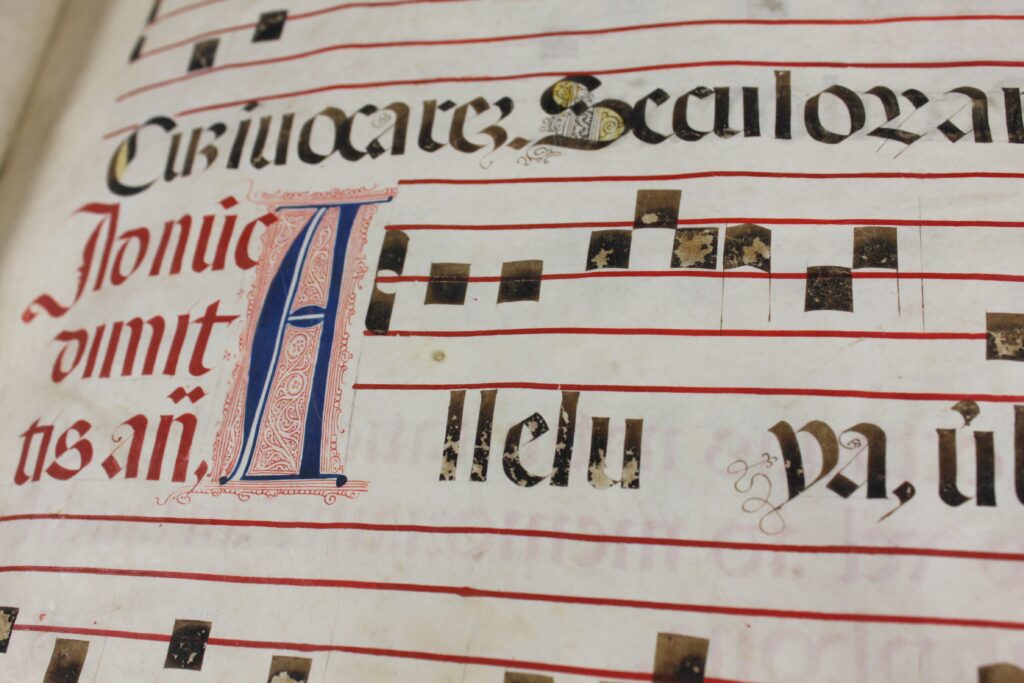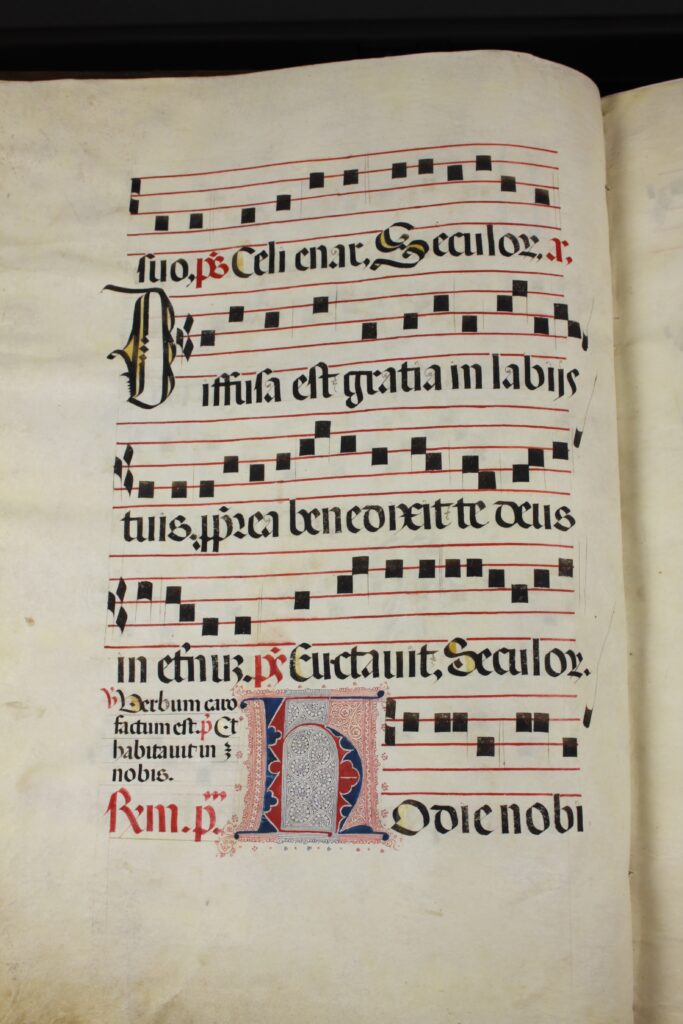In 2019, as the University of Dayton prepared for the dedication of the University Libraries newly-renovated spaces, a brief history and exhibit of the university libraries was researched and created. Among the artifacts displayed was an interesting journal kept by the former head librarian, Brother Walter Roesch, SM, who managed the library from 1954-1962. This small, leather-bound notebook held daily notations of Roesch’s activities, as well as his hopes for the library.
A June 13, 1958, entry in his journal indicates that Roesch was in the process of “negotiating for a manuscript sample from Philip Duschnes,” whom he believed to be a reliable dealer. The item, which Roesch described as, “Antiphonal 16th century Spanish 240 page, 21 inch example,” matches several elements of the book known on campus as the Spanish Antiphonary M2149.5 .C5 C5.
This antiphonary is being prepared to make a trip to Indiana University Bloomington as part of the Peripheral Manuscripts Project. Brother Roesch’s journal entry provides new and important information for the book’s provenance.
The book, an antiphonary for the Liturgy of the Hours, formerly called the Divine Office, has become popular with faculty in various departments. It first caught the attention of musicology professor Samuel Dorf in 2010 during a visit to explore the Zimmerman Collection of instruments from around the world. The late special collections curator Nicoletta Hary noted his interest and asked if he would like to see the antiphonary. He’s brought his students back every year to sing from it. The sturdy volume — 58 centimeters tall with large Gothic script and plainsong notation — contains 242 vellum sheets of mostly Christmastide antiphons — sung or chanted verses used in liturgy.
But describing it adequately in the Libraries catalog proved vexing because of what details were not apparent beyond its nature, dimensions, contents and construction, such as its origin, its age, its creators and its purpose, said special collections cataloger Joan Milligan, who in 2017 invited about a half-dozen Marian Library faculty, staff and students to stop by and give input. For them, seeing it was like … well, Christmas morning.
Paging through it, they translated bits of Latin and noted the subjects of the antiphons, which begin with the feast of Christmas and continue through the fourth Sunday after Epiphany. Because their order was not consistent with that of the Roman Rite set at the Council of Trent (1545‒1563), they posited that the book was pre-Tridentine. A student spied a Dominican cross in the ornate illustration on the first page, which hinted that the prayers’ sequencing may have been in accordance with that order’s rites.
It also includes antiphons for additional feasts. Religious orders often incorporate devotions of particular interest to them; this one includes the feast of St. Vincent of Saragossa, the first Spanish martyr (Jan. 22). It also includes songs for the feasts of St. Agnes (Jan. 21) and St. Gabriel the Archangel (celebrated at various times in the past on March 18, a week before the Annunciation, and March 24, a day before). The inclusion of St. Gabriel’s feast, coming so long after Epiphany, is one of the mysteries remaining.
Though certainty about the antiphonary’s history has grown with each clue discovered, the Peripheral Manuscripts Project is sure to reveal even more, Schulz said — particularly when the high-end digital version becomes available to scholars worldwide.
But just like with Christmas, she said, waiting is the hardest part.
This blog was written by both Kristina Schulz, University Archivist and Coordinator of Special Collections and Maureen Schlangen, E-scholarship and Communications Manager at the University of Dayton.





Thank you for this article. I would love to see the book. I found a nearly identical page this February in a thrift store in New Mexico. Looking them up on the internet will reveal that they are not uncommon things (singular pages – it’s sad that these books were dismantled for sale. ) to find on auction sites for relatively low prices – given that they are 500 years old! That doesn’t dilute my appreciation of it though. My particular page is the portion of scripture with Jesus calling Lazarus from the tomb.